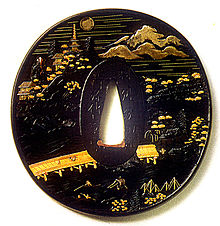Shakudō
- Shakudō
-

Tsuba en shakudō,
avec incrustation d'
or représentant une vue du lac Biwa,
signé Denshichi,
1778.
Le shakudō (赤銅, shakudō?) est un alliage d'or et de cuivre (typiquement 4 % d'or, 96 % de cuivre), principalement utilisé en raison de sa patine bleu-violet foncée.
Historique
Le shakudō était historiquement utilisé au Japon pour décorer des éléments de katana tels le tsuba (la garde). Lors de son introduction en occident au milieu du XIXe siècle, il a été considéré comme inconnu en dehors d'Asie mais des études récentes ont suggéré des similitudes avec des alliages utilisés en Égypte, en Grèce, ou à Rome[1]. Les artisans joaillers modernes ont contribuer à faire renaître l'utilisation de cet alliage comme élément de décoration, spécialement pour la technique du mokume-gane (en).
Shakudō est parfois utilisé comme un terme général désignant les objets décoratifs damasquinés d'origine japonaise, également connus en occident comme étant du damasquinage Amita, du nom d'un fabricant du XXe siècle exportant ce type de pièces.
Notes et références
(en) Cet article est partiellement ou en totalité issu de l’article en anglais intitulé « Shakudō » (voir la liste des auteurs)
Voir aussi
Sur les autres projets Wikimedia :
Articles connexes
Liens externes
Wikimedia Foundation.
2010.
Contenu soumis à la licence CC-BY-SA. Source : Article Shakudō de Wikipédia en français (auteurs)
Regardez d'autres dictionnaires:
Shakudō — Blech Shakudō (jap. 赤銅, dt. „Rotkupfer“) ist eine traditionelle japanische Metalllegierung, die nachweislich seit dem 12. Jahrhundert für Verzierungen auf Schwertern (siehe auch: Tanto, Wakizashi, Katana) oder Schmuckgegenständen verwendet wird.… … Deutsch Wikipedia
Shakudō — (赤銅) is a billon of gold and copper (typically 4% Gold, 96% Copper), mostly designed for its beautiful dark blue purple patina. It was historically used in Japan to decorate katana fittings such as tsuba and yatate. When it was introduced to the… … Wikipedia
Shakudo — Shakudō (jap. 赤銅, dt. „Rotkupfer“) ist eine traditionelle japanische Metalllegierung die nachweislich seit dem 12. Jahrhundert für Verzierungen auf Schwertern oder Schmuckgegenständen verwendet wird. Die Legierung besteht üblicherweise aus Kupfer … Deutsch Wikipedia
shakudo — /shakˈŭ dō or dōˈ/ noun An alloy of copper and a small percentage of gold, used in Japanese decorative art, esp in sword fittings, to give a blue black patina adjective Made of or with shakudo ORIGIN: Jap … Useful english dictionary
Shakudo — Shak u*do (sh[a^]k [oo^]*d[=o] ), n. [Jap.] An alloy of copper, invented by the Japanese, having a very dark blue color approaching black. [Webster 1913 Suppl.] … The Collaborative International Dictionary of English
shakudo — In Japanese tradition, an alloy of copper, with about 2 5% gold … Glossary of Art Terms
Shakudo Station — is a train station owned by Kintetsu Corporation in Katsuragi, Nara Prefecture, Japan. Lines * Kintetsu:* Minami Osaka Line:* Gose Line Layout * There are 2 island platforms with 4 tracks on the ground. The ticket gates and the ticket machines… … Wikipedia
Mokume-gane — Example of Mokume gane patterns in gold and silver alloys Mokume gane brass/copper billet Mokume gane ( … Wikipedia
Corinthium aes — Korinthisches Erz (lateinisch: aes Corinthium, häufiger Corinthium aes) ist schon im Römischen Reich hochgeschätztes Metall, wobei jedoch schon ägyptische Quellen auf seine Herstellung und Eigenschaften eingehen[1]. Es ist eine Bronze oder… … Deutsch Wikipedia
Ōsaka Abenobashi Station — Abenobashi redirects here. For the anime, see Magical Shopping Arcade Abenobashi. Ōsaka Abenobashi Station 大阪阿部野橋駅 Osaka Abenobashi Station (July 2004) … Wikipedia

